Modeling Study on Key Factors Related to Changes in Sea Fog Formation on the Western Coast of the Korean Peninsula
Abstract
1. Introduction
2. Data Source and Model Introduction
2.1. Introduction of the Saemanguem Seawall
2.2. Data Source
- (1)
- Meteorological Aviation Report (METAR) of Gunsan Airport: Visibility, cloud ceiling, wind speed, temperature, and humidity data were obtained from the METAR of Gunsan Airport, where observations were conducted every hour from 2000 to 2019.
- (2)
- METAR of Seosan Airport during the same period: Seosan Airport, highlighted by a yellow square in Figure 2, is also adjacent to the west coast and has similar characteristics of frequent sea fog to Gunsan Airport; therefore, the visibility and cloud ceiling data of Seosan Airport were used as environmental data to compare sea fog changes at Gunsan Airport after the construction of the Saemangeum Seawall.
- (3)
- The monthly mean SST for 2010–2023 observed in the weather bouy of Eoiyeondo (red dot in Figure 2).
- (4)
- The monthly mean SST in 2023 at two locations on and around the Saemangeum Seawall.
2.3. Model Introduction
3. Methodology
3.1. Statistical Approach
3.2. Experimental Settings
4. Results
Model Experiments
5. Summary and Conclusions
Author Contributions
Funding
Institutional Review Board Statement
Informed Consent Statement
Data Availability Statement
Conflicts of Interest
Abbreviations
| WRF model | Weather Research and Forecasting model |
| SST | Sea Surface Temperature |
| TKE within the PBL | Turbulence Kinetic Energy within the Planetary Boundary Layer |
| 3D | Three-dimensional |
| KMA | Korea Meteorological Administration |
| GK-2A | Geostationary Korea Multi-Purpose Satellite 2A |
| METAR | Meteorological Aviation Report |
| ERA5 | ECMWF Reanalysis 5th Generation |
| EGIS | Environmental Geographic Information System |
| USGS | United States Geological Survey |
| OISST | Optimum Interpolation Sea Surface Temperature |
References
- Hong, S.G. Aviation Meteorology; Kyohakyungusa, Ltd.: Seoul, Republic of Korea, 2019; pp. 189–191. (In Korean) [Google Scholar]
- Gultepe, I.; Tardif, R.; Michaelides, S.C.; Cermak, J.; Bott, A.; Bendix, J.; Müller, M.D.; Pagowski, M.; Hansen, B.; Ellrod, G.; et al. Fog research: A review of past achievements and future perspectives. Pure Appl. Geophys. 2007, 164, 1121–1159. [Google Scholar] [CrossRef]
- Kim, M.H.; Park, S.W.; Bae, J.H. Flight Delay and Cancellation Analysis and Management Strategies; Korea Transport Institute: Seoul, Republic of Korea, 2020; pp. 13–29. Available online: https://www.nkis.re.kr/subject_view1.do?otpId=OTP_0000000000006140 (accessed on 15 September 2025). (In Korean)
- Taylor, G.I. The formation of fog and mist. Quart. J. Royal. Meteorool. Soc. 1917, 43, 241–268. [Google Scholar] [CrossRef]
- Lee, H.Y.; Chang, E.C. Impact of land-sea thermal contrast on the inland penetration of sea fog over the coastal area around the Korean peninsula. JGR Atmos. 2018, 123, 6487–6504. [Google Scholar] [CrossRef]
- Liu, L.; Wang, X.; Li, Y.; Wei, W. The effect of sea surface temperature on relative humidity and atmospheric visibility of a winter sea fog event over the Yellow-Bohai sea. Atmosphere 2022, 13, 1718. [Google Scholar] [CrossRef]
- Wang, S.; Li, Y.; Shi, X.; Chen, X. The microphysical properties of a sea-fog event along the west coast of the Yellow Sea in spring. Atmosphere 2020, 11, 413. [Google Scholar] [CrossRef]
- Zhang, S.P.; Xie, S.P.; Liu, Q.Y.; Yang, Y.Q.; Wang, X.G.; Ren, Z.P. Seasonal variations of yellow Sea fog: Observations and mechanisms. J. Clim. 2009, 22, 6758–6772. [Google Scholar] [CrossRef]
- Koračin, D.; Dorman, C.E.; Lewis, J.M.; Hudson, J.G.; Wilcox, E.M.; Torregrosa, A. Marine fog: A review. Atmos. Res. 2014, 143, 142–175. [Google Scholar] [CrossRef]
- Lee, E.; Kim, J.H.; Heo, K.Y.; Cho, Y.K. Advection fog over the eastern Yellow Sea: WRF simulation and its verification by satellite and in situ observations. Remote Sens. 2021, 13, 1480. [Google Scholar] [CrossRef]
- Lakra, K.; Avishek, K. A review on factors influencing fog formation, classification, forecasting, detection and impacts. Rend. Lincei. Sci. Fis. Nat. 2022, 33, 319–353. [Google Scholar] [CrossRef]
- Hwang, J.D.; Chang, E.C. A Statistical Study on the Characteristics of Costal Sea Fog in Gunsan following Saemangeum Seawall construction. Korean J. Earth Sci. 2025, in print. [Google Scholar]
- Nakanishi, M. Large-Eddy simulation of radiation fog. Bound. Layer Meteorol. 2000, 94, 461–493. [Google Scholar] [CrossRef]
- Koračin, D.; Lewis, J.; Thompson, W.T.; Dorman, C.E.; Businger, J.A. Transition of stratus into fog along the California coast: Observations and modeling. J. Atmos. Sci. 2001, 58, 1714–1731. [Google Scholar] [CrossRef]
- Koračin, D.; Businger, J.A.; Dorman, C.E.; Lewis, J.M. Formation, evolution, and dissipation of coastal sea fog. Bound. Layer Meteorol. 2005, 117, 447–478. [Google Scholar] [CrossRef]
- Gultepe, I.; Milbrandt, J.A. Microphysical observations and mesoscale model simulation of a warm fog case during FRAM project. Pure Appl. Geophys. 2007, 164, 1161–1178. [Google Scholar] [CrossRef]
- Heo, K.Y.; Ha, K.J. A coupled model study on the formation and dissipation of sea fogs. Mon. Weather Rev. 2010, 138, 1186–1205. [Google Scholar] [CrossRef]
- Guo, J.; Xu, J.; Xu, X. An observational and modeling study of a sea fog event over the yellow and east China seas on 17 March 2014. Trop. Cyclone Res. Rev. 2021, 2021, 182–190. [Google Scholar] [CrossRef]
- Li, P.Y.; Fu, G.; Lu, C.G.; Fu, D.; Wang, S. The formation mechanism of a spring sea fog event over the Yellow-Sea associated with a low-level jet. Weather. Forecast. 2012, 27, 1538–1553. [Google Scholar] [CrossRef]
- Han, L.; Zhang, S.; Xu, F.; Lü, J.; Lu, Z.; Ye, G.; Chen, S.; Xu, J.; Du, J. Simulations of sea fog case impacted by air–sea interaction over South China Sea. Front. Mar. Sci. 2022, 9, 1000051. [Google Scholar] [CrossRef]
- Stoelinga, M.T.; Warner, T.T. Nonhydrostatic, mesobeta-scale model simulations of cloud ceiling and visibility for an East Coast winter precipitation event. J. Appl. Meteorol. 1999, 38, 385–404. [Google Scholar] [CrossRef]
- Lee, Y.H.; Won, D.J.; Kim, K.E.; Min, K.D. The role of turbulence in numerical model on the sea fog over the Yellow-sea. Asia Pac. J. Atmos. Sci. 2000, 36, 643–654. Available online: https://www.dbpia.co.kr/journal/articleDetail?nodeId=NODE00942244 (accessed on 15 September 2025). (In Korean).
- Pahlavan, R.; Moradi, M.; Tajbakhsh, S.; Azadi, M.; Rahnama, M. Fog probabilistic forecasting using an ensemble prediction system at six airports in Iran for 10 fog events. J. Appl. Meteorol. 2021, 28, e2033. [Google Scholar] [CrossRef]
- Xu, D.; Chen, H.; Chen, Y.; Liu, D.; Ge, F.; Ye, X.; Sun, Q.; Shen, F. The impact of assimilating FY-3D microwave humidity sounder II radiance data on the analysis and forecast of two advection fog cases. Atmos. Res. 2025, 323, 108162. [Google Scholar] [CrossRef]
- Sim, S.; Im, J.; Jung, S.; Han, D. Improving short-term prediction of ocean fog using numerical weather forecasts and geostationary satellite-derived ocean fog data based on AutoML. Remote Sens. 2024, 16, 2348. [Google Scholar] [CrossRef]
- Shin, S.C. The Changed View of Saemangeum from the Sky. The Today Gunsan, 5 November 2020. Available online: http://www.todaygunsan.co.kr/news/articleView.html?idxno=3433 (accessed on 15 September 2025). (In Korean).
- Lee, H.J.; Jo, H.R.; Kim, M.J. Topographical changes and textural characteristics in the areas around the Saemangeum dyke. Ocean Polar Res. 2006, 28, 293–303. (In Korean) [Google Scholar] [CrossRef]
- Gunsan City, South Korea. Satellite Imagery; Google: Earth. Available online: https://earth.google.com (accessed on 17 July 2025).
- Durran, D.R.; Klemp, J.B. On the effects of moisture on the Brunt-Väisälä frequency. J. Atmos. Sci. 1992, 39, 2152–2158. [Google Scholar] [CrossRef]
- Morrison, H.; Thompson, G.; Tatarskii, V. Impact of cloud microphysics on the development of trailing stratiform precipitation in a simulated squall line: Comparison of one and two-moment schemes. Mon. Weather Rev. 2009, 137, 991–1007. [Google Scholar] [CrossRef]
- Ozmen, Y.; Baydar, E.; Beeck, J.P.A.J. Wind flow over the low-rise building models with gabled roofs having different pitch angles. Build. Environ. 2016, 95, 63–74. [Google Scholar] [CrossRef]
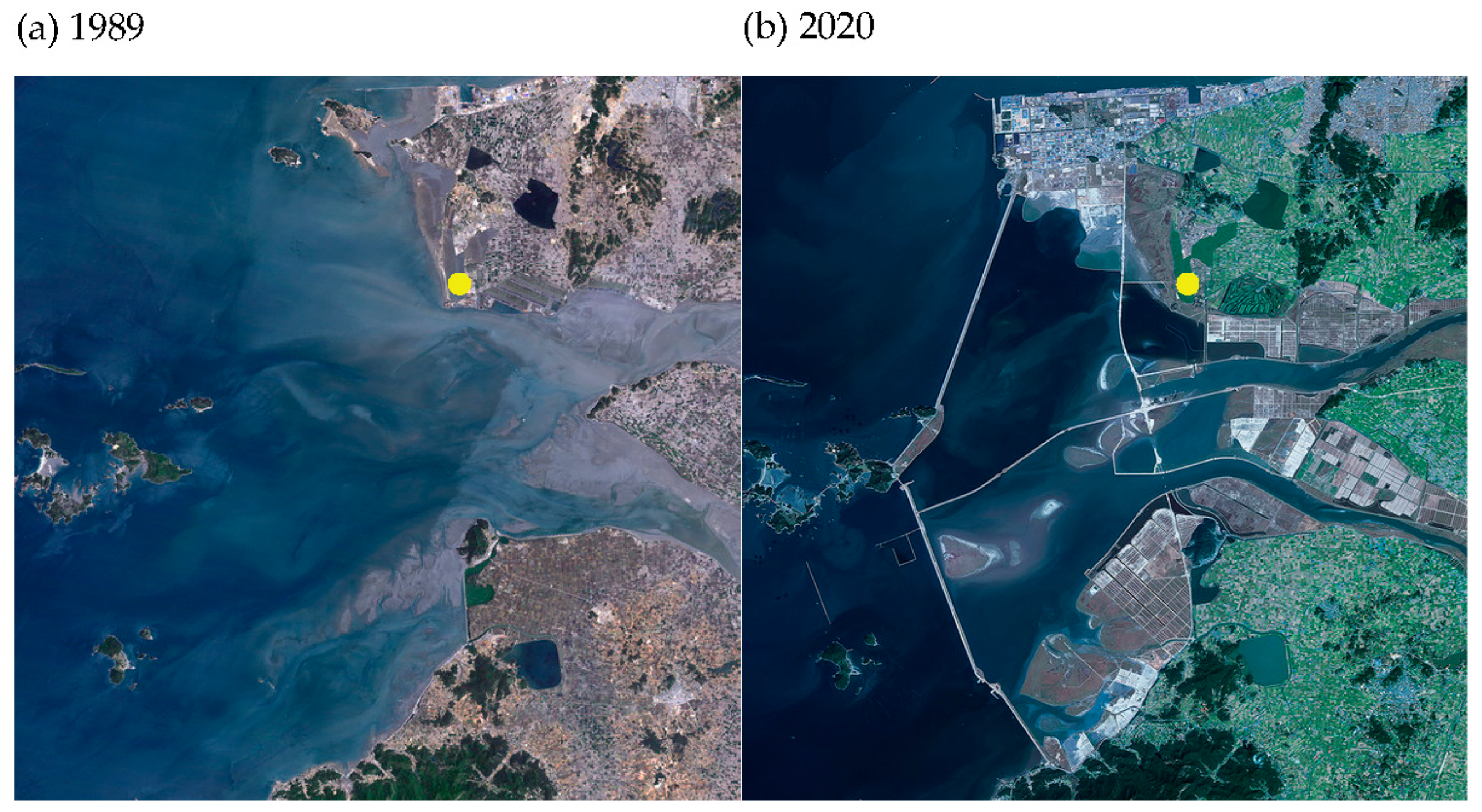
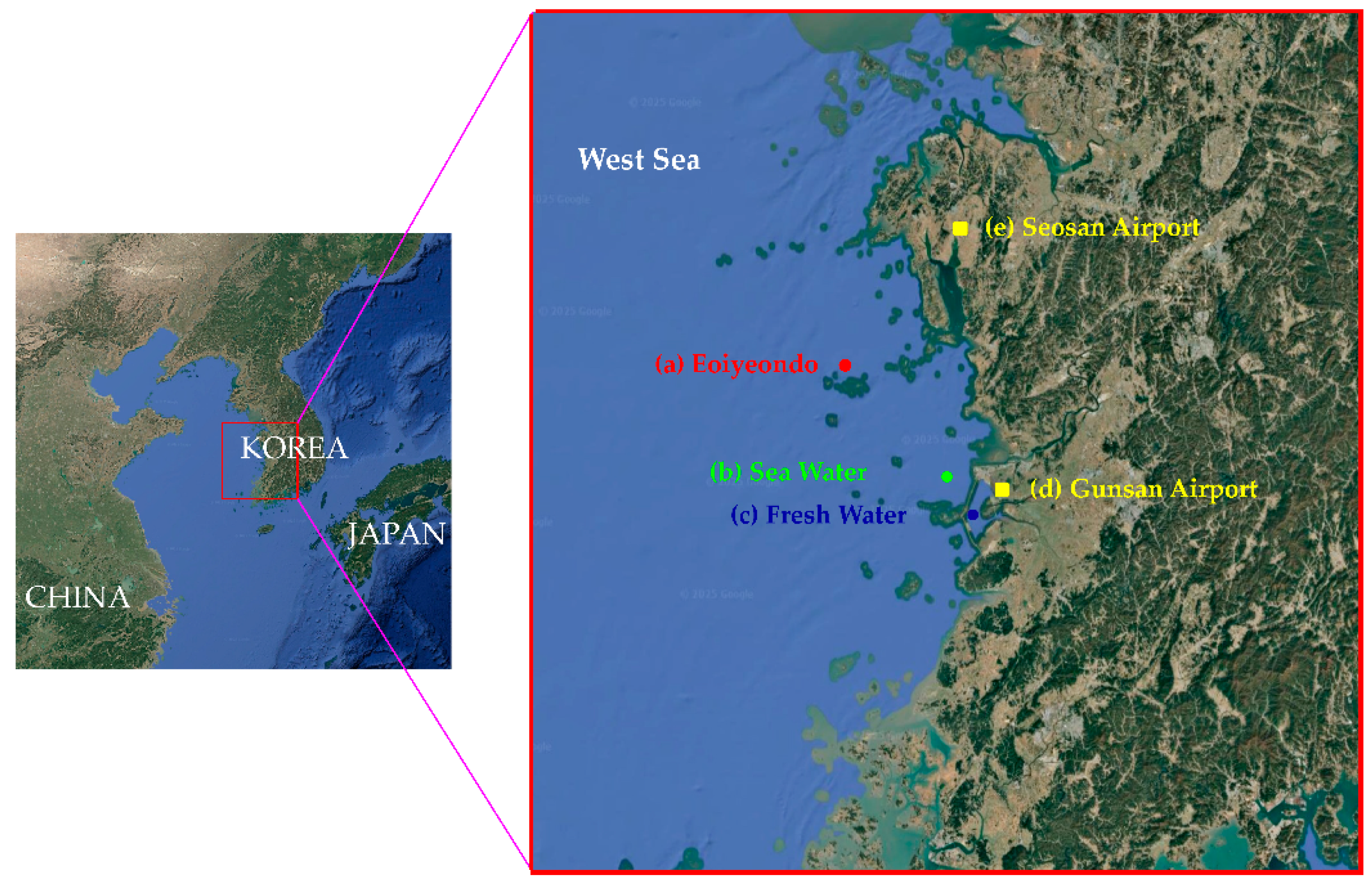



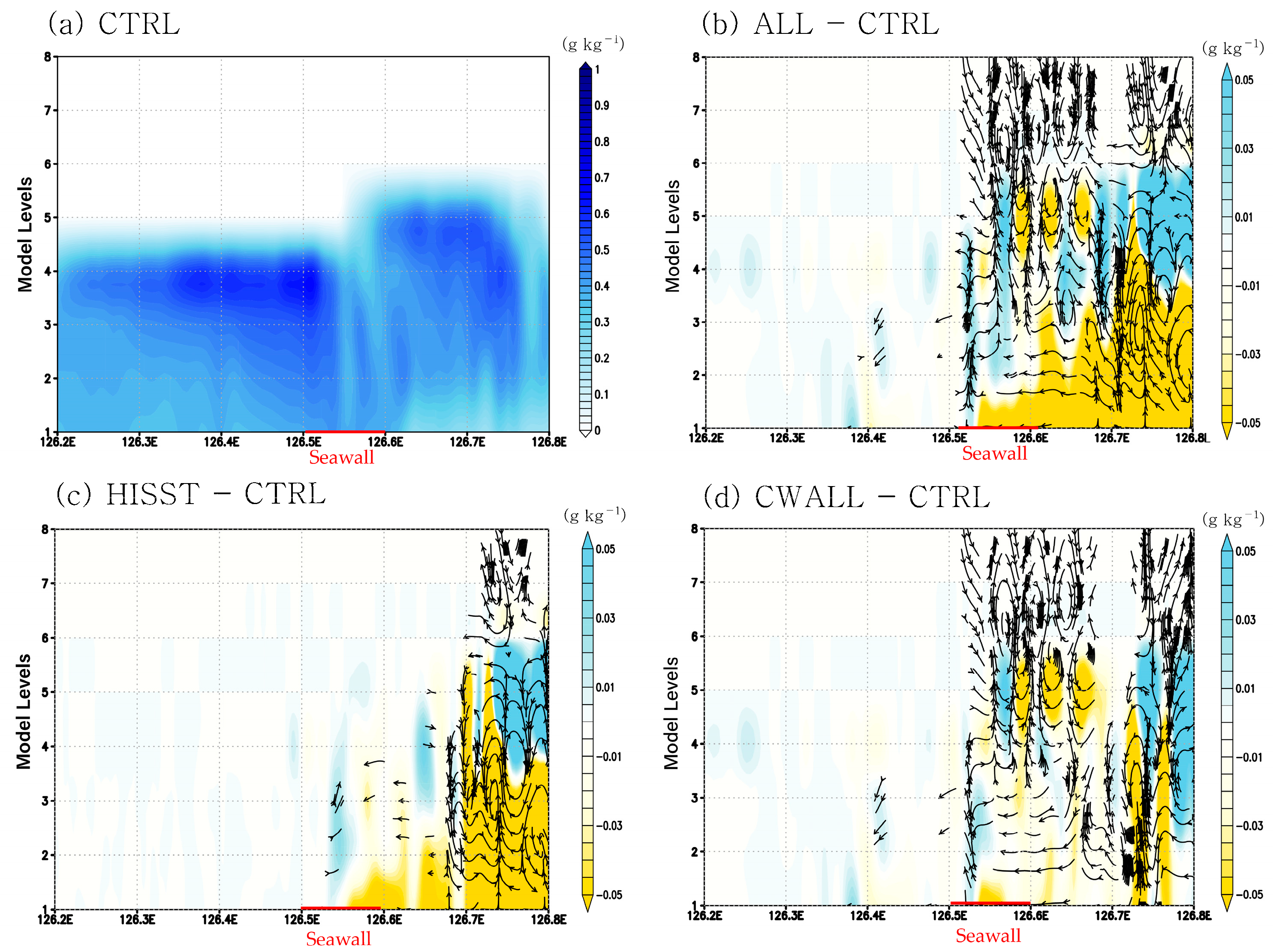
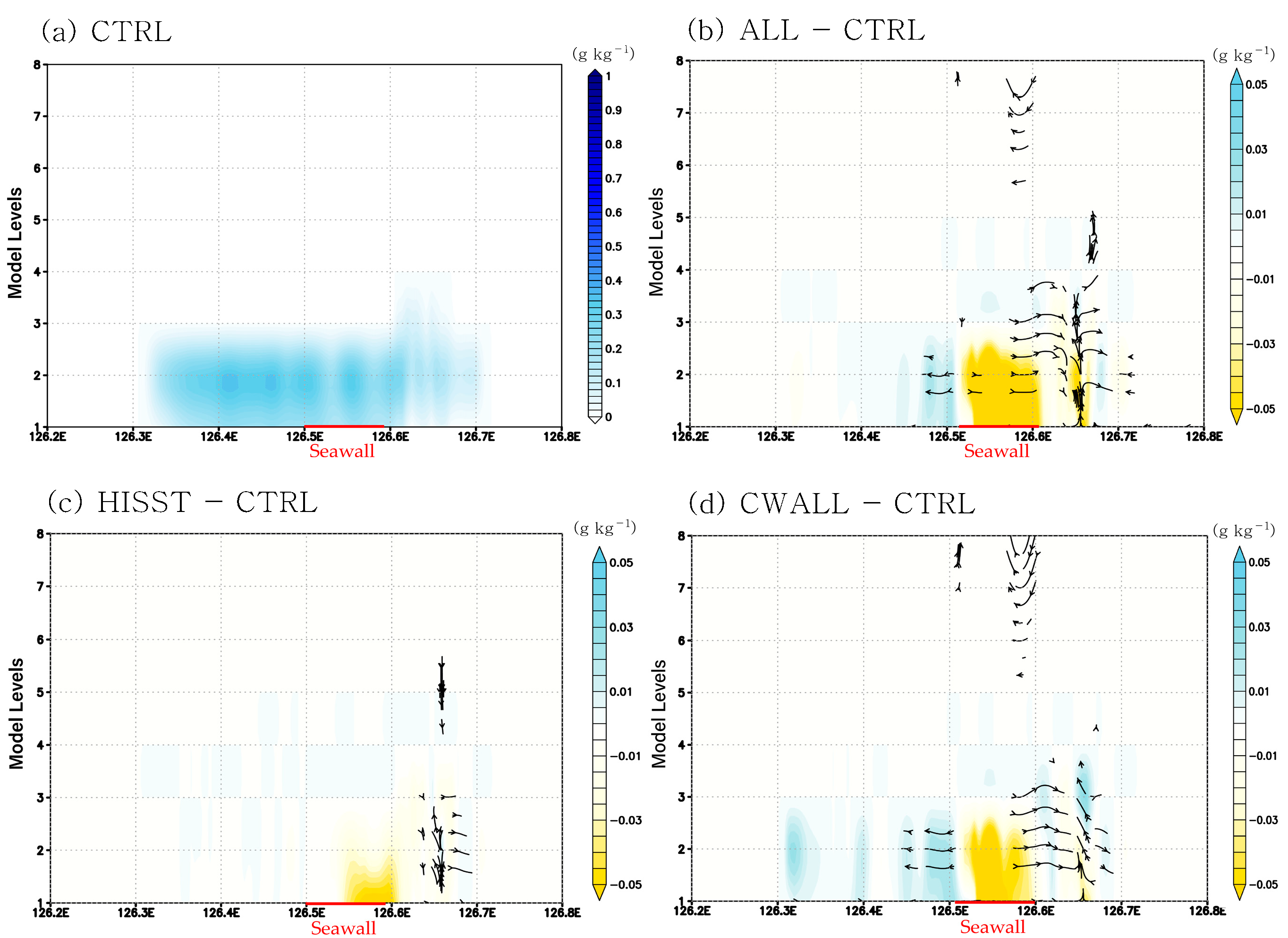
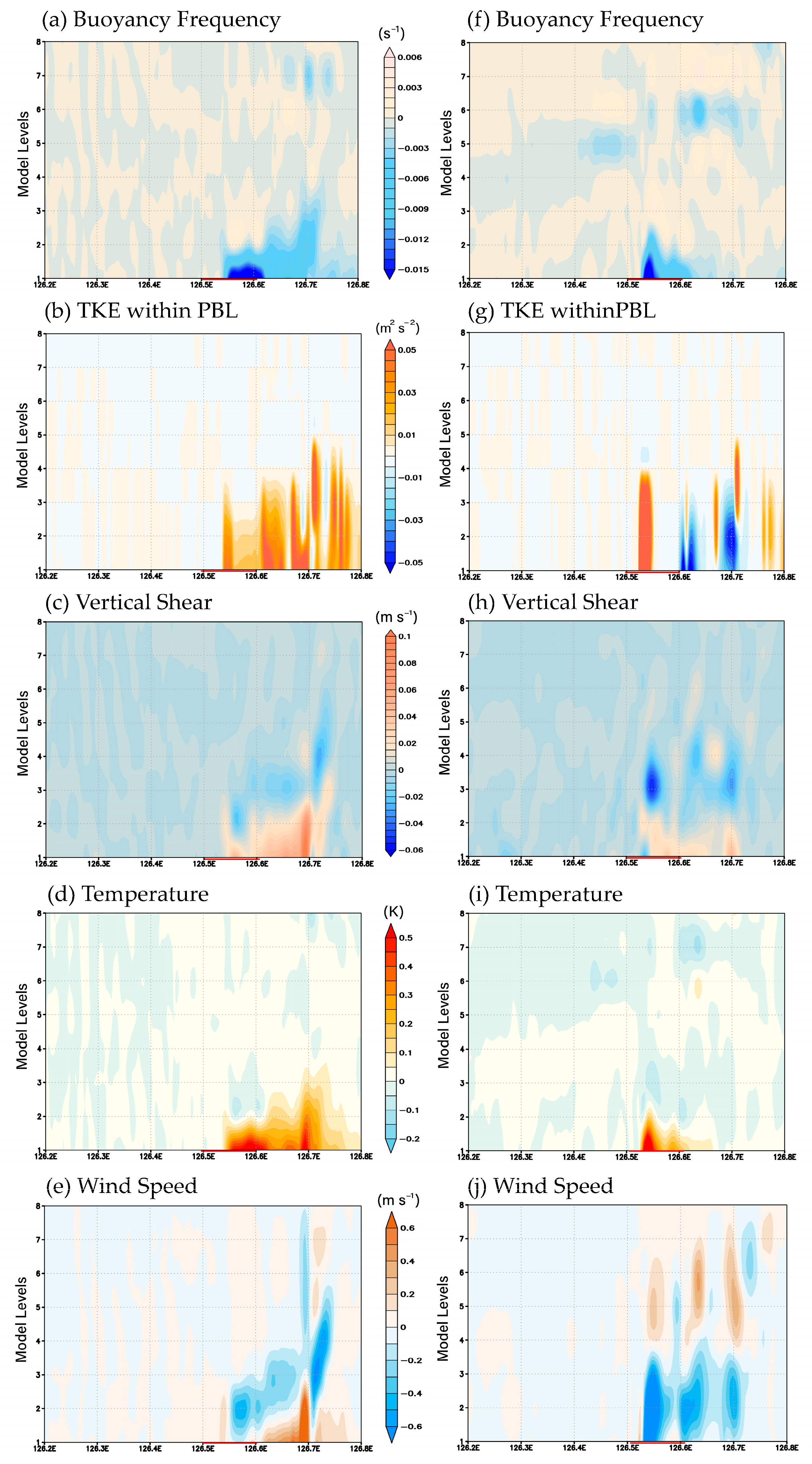
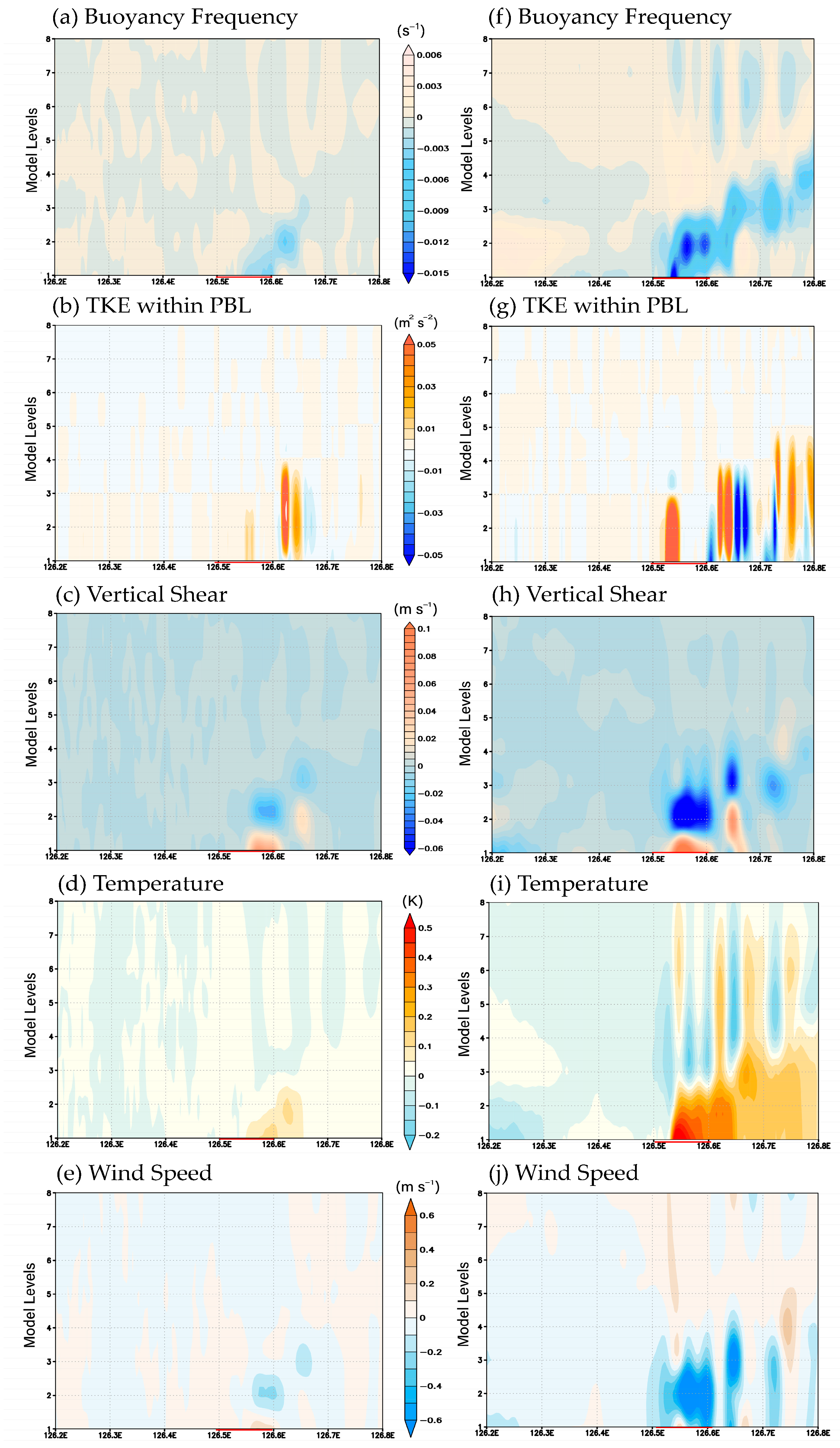
| WRF v4.2.2 | ||
|---|---|---|
| Horizontal Resolution | Domain 1 2.5 km | Domain 2 0.5 km |
| Model Layers | 45 | |
| Time Step | 15 s | |
| Initial & Lateral Boundary | ERA5 Reanalysis, OISST | |
| Microphysics | Thompson | |
| Cumulus | Tiedtke | |
| Longwave Radiation | RRTMG | |
| Shortwave Radiation | RRTMG | |
| Planetary Boundary Layer | MYJ | |
| Land Surface | Unified Noah | |
| SST in Heavy Fog Season (°C) | Yearly Mean SST (°C) | Annual Deviation (°C) | |||||
|---|---|---|---|---|---|---|---|
| MAR | APR | MAY | JUN | JUL | |||
| (a) Eoiyeondo | 6.7 | 8.9 | 14.3 | 21.3 | 24.7 | 15.7 | 21.5 |
| (b) Sea water | 7.1 | 11.0 | 16.0 | 20.8 | 25.0 | 15.4 | 22.1 |
| (c) Fresh water | 8.0 | 12.6 | 18.4 | 23.5 | 26.4 | 16.4 | 24.9 |
| (d) Surface Temperature at Gunsan Airport | 5.7 | 11.3 | 17.2 | 21.7 | 25.9 | 13.1 | 27.6 |
| Experiment | CTRL | CWALL | HISST | ALL |
|---|---|---|---|---|
| Seawall application | × | ○ | × | ○ |
| SST application | × | × | ○ | ○ |
| Element | Status Change | Impact of Changes in Each Element | |
|---|---|---|---|
| Buoyancy frequency | Lower: decrease (−) | Increased atmospheric instability → Strengthen upward motion → Fog dissipation, Cloud condensation | |
| TKE within the PBL | Lower: increase (+) | Enhanced atmospheric mixing → Water vapor supply → Saturation layer expansion | |
| Vertical Shear | Upper: decrease (−) Lower: increase (+) | vertical airflow enhancement → fog dissipation | |
| Temperature | Upper: decrease (−) Lower: increase (+) | Air Parcel rise → Insulation expansion → Cooling → Condensation → Cloud formation | |
| Wind speed | HISST | Upper: decrease (−) Lower: increase (+) | vertical airflow enhancement → fog dissipation |
| CWALL | Upper: increase (+) Lower: decrease (−) | Turbulence occurs → atmospheric instability increases | |
Disclaimer/Publisher’s Note: The statements, opinions and data contained in all publications are solely those of the individual author(s) and contributor(s) and not of MDPI and/or the editor(s). MDPI and/or the editor(s) disclaim responsibility for any injury to people or property resulting from any ideas, methods, instructions or products referred to in the content. |
© 2025 by the authors. Licensee MDPI, Basel, Switzerland. This article is an open access article distributed under the terms and conditions of the Creative Commons Attribution (CC BY) license (https://creativecommons.org/licenses/by/4.0/).
Share and Cite
Hwang, J.-D.; Gwak, C.-Y.; Chang, E.-C. Modeling Study on Key Factors Related to Changes in Sea Fog Formation on the Western Coast of the Korean Peninsula. Atmosphere 2025, 16, 1253. https://doi.org/10.3390/atmos16111253
Hwang J-D, Gwak C-Y, Chang E-C. Modeling Study on Key Factors Related to Changes in Sea Fog Formation on the Western Coast of the Korean Peninsula. Atmosphere. 2025; 16(11):1253. https://doi.org/10.3390/atmos16111253
Chicago/Turabian StyleHwang, Jae-Don, Chan-Yi Gwak, and Eun-Chul Chang. 2025. "Modeling Study on Key Factors Related to Changes in Sea Fog Formation on the Western Coast of the Korean Peninsula" Atmosphere 16, no. 11: 1253. https://doi.org/10.3390/atmos16111253
APA StyleHwang, J.-D., Gwak, C.-Y., & Chang, E.-C. (2025). Modeling Study on Key Factors Related to Changes in Sea Fog Formation on the Western Coast of the Korean Peninsula. Atmosphere, 16(11), 1253. https://doi.org/10.3390/atmos16111253





